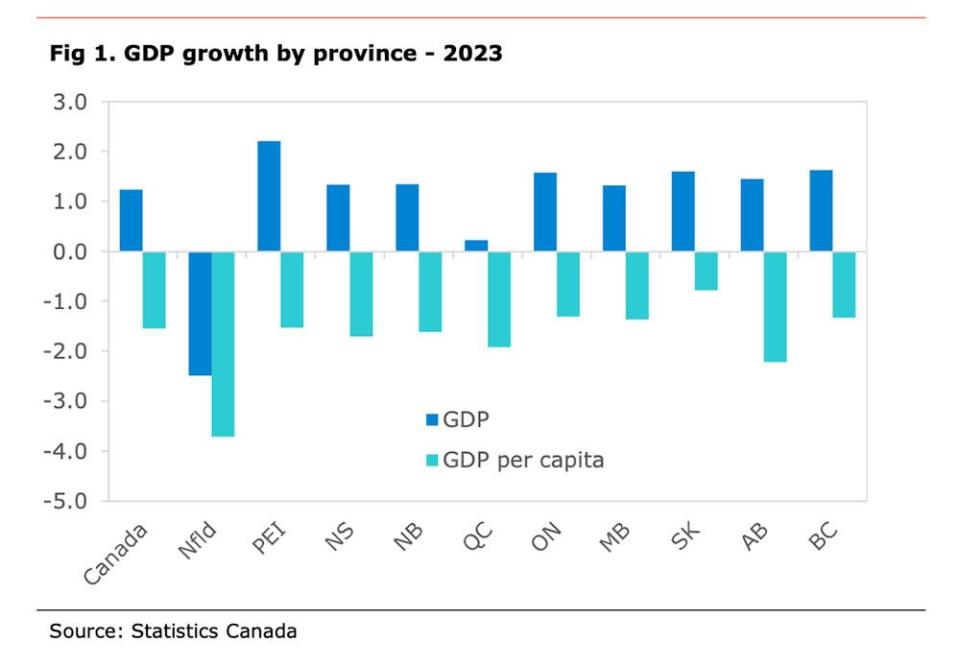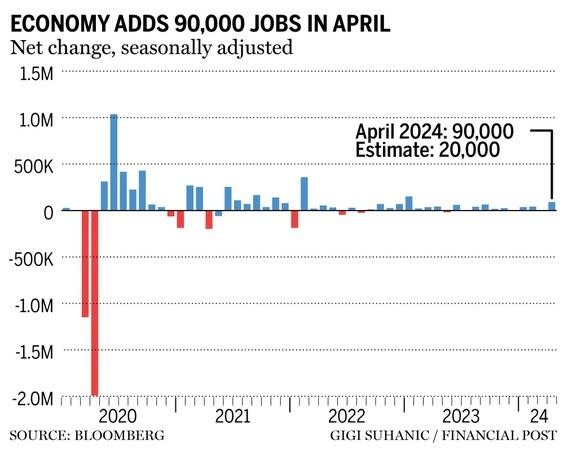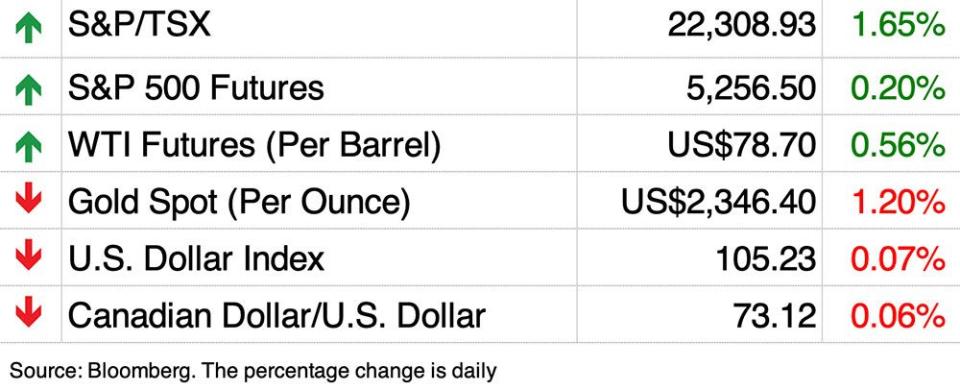Posthaste: This province's growth plunged and it's still whomping the rest of Canada


Alberta has been a powerhouse in Canada since the pandemic, with country-beating growth and a housing market that has stood strong while others slumped under the weight of higher interest rates.
But an “interesting divergence” emerged in recent gross domestic product data for the provinces, says Charles St-Arnaud, chief economist at Alberta Central.
After leading Canada with 5.3 per cent growth in 2022, economic activity in this province slowed to 1.5 per cent in 2023, missing forecasts by a percentage point.
Growth was higher than Canada’s 1.2 per cent showing, but just about the middle of the pack for the provinces, said St-Arnaud in a recent note.

And when you look at GDP per capita, Alberta’s performance is one of the weakest, declining 2.2 per cent in 2023, compared to 1.5 per cent for Canada as a whole.
Only Newfoundland declined more, dropping 3.7 per cent.
The fall in per capita growth partly reflects the surge in population Alberta saw last year, its strongest rise since 1982.
But it’s also the result of a decline in investment in the province that has been whittling away at the so-called “Alberta Advantage” since 2015.
“Alberta’s performance relative to the rest of the country is closely linked to the investment cycle in the province, with Alberta’s income outperforming the rest of the country when investment as a share of GDP rises and underperforming when it shrinks,” said St-Arnaud.
For years now, Alberta’s economy has not been experiencing the booms seen in the past when oil prices were high.
The reasons for this, St-Arnaud explains in an earlier study, is that a larger share of oil revenues are being returned to shareholders, leaving a smaller share to be reinvested in operations in the province.
Last year about 13 per cent of revenues were returned to shareholders, compared to 3 per cent in 2014. Not only that, about 75 per cent of those shareholders were foreigners, meaning the money left the country, said St-Arnaud.
Oil producers also reinvested a smaller share of revenues in their companies, falling to 7 per cent of revenues from 25 per cent in 2014.
Because of the decline in 2023, Alberta’s GDP per capita is now $71,900, its lowest level since 2010 if the pandemic is excluded. That’s down 11 per cent from its peak in 2014.
“Moreover, when looking at a longer period, GDP per capita is currently at the same level as it was in 2004, implying little to no increase in wealth in two decades,” said St-Arnaud.
Alberta is far from a light-weight. Even with the decline, the province’s GDP per capita soars above the rest of the country, beating its closest contender, Saskatchewan, by 10 per cent.
It is 30 per cent higher than the country as a whole, making Alberta the wealthiest province by this measure.
Yet it’s still a comedown from 2014, when growth per person was 50 per cent higher than the rest of the country.
And the decline is likely to continue in 2024, said St-Arnaud. He predicts GDP growth to be between 2 and 2.5 per cent this year, and with the population continuing to rise, GDP per capita could fall 1 to 1.5 per cent further.
Sign up here to get Posthaste delivered straight to your inbox.

Canada’s job numbers raised a few eyebrows Friday when the 90,000 gain smashed the forecast of 20,000.
Markets immediately reacted by lowering the odds of a June rate cut by the Bank of Canada to 50 per cent from 75 per cent before the data came out.
The surprise strength of the job market prompted Capital Economics to push back its forecast for the first rate cut to July.
Others argued that despite the headline gain, the labour market still showed signs of weakening.
The 90,000 jobs created in April fell short of the 112,000 new working-age entrants, keeping the unemployment at 6.1 per cent.
“With the unemployment rate remaining higher than it was at the start of the year and wage pressures easing slightly, the data is still consistent with a gradual loosening of labour market conditions,” said Andrew Grantham, a senior economist at CIBC Capital Markets.
One thing is for sure though, the jobs rebound will make the next inflation report on May 21 that much more important to the Bank of Canada’s rate decision on June 5.
Today’s Data: Canadian building permits for March
Earnings: Emera Inc, Premium Brands Holding Corp

How TD’s money-laundering crisis is making its succession dilemma ‘messy and complicated’
Why saving for a downpayment is next to impossible in Canada’s major markets
Congratulations to anyone who continues to learn into their retirement years, but that does raise a question about funding. Certified financial planner Janet Gray says using your registered retirement savings plan to fund a lifelong learning plan is a good idea, but there are a few things to know. Find out more at FP Investor.
Are you worried about having enough for retirement? Do you need to adjust your portfolio? Are you wondering how to make ends meet? Drop us a line at aholloway@postmedia.com with your contact info and the general gist of your problem and we’ll try to find some experts to help you out while writing a Family Finance story about it (we’ll keep your name out of it, of course). If you have a simpler question, the crack team at FP Answers led by Julie Cazzin or one of our columnists can give it a shot.
McLister on Mortgages
Want to learn more about mortgages? Mortgage strategist Robert McLister’s Financial Post column can help navigate the complex sector, from the latest trends to financing opportunities you won’t want to miss. Read them here
Today’s Posthaste was written by Pamela Heaven with additional reporting from Financial Post staff, The Canadian Press and Bloomberg.
Have a story idea, pitch, embargoed report, or a suggestion for this newsletter? Email us at posthaste@postmedia.com.
Bookmark our website and support our journalism: Don’t miss the business news you need to know — add financialpost.com to your bookmarks and sign up for our newsletters here.

 Yahoo Finance
Yahoo Finance 




